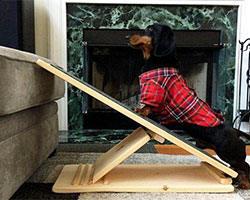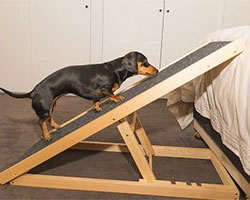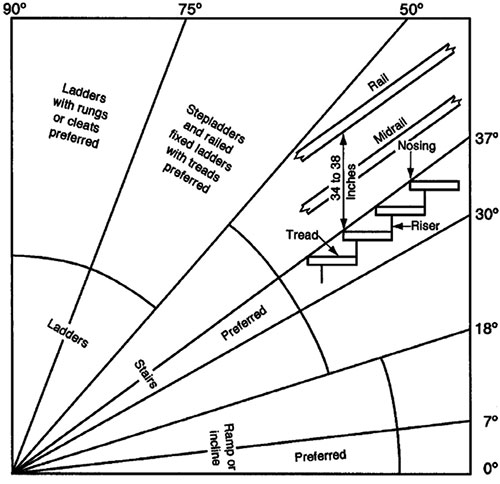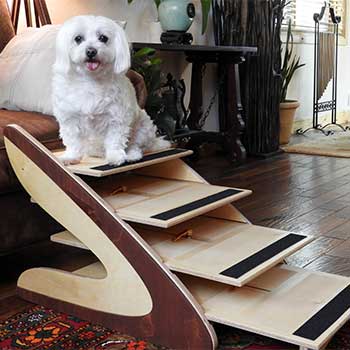Dog Ramps

How to Buy Dog Ramps
The problem with dog ramps lies with the angle. The steeper the angle the more reasons to not use a ramp.A dog’s paws, like human feet, have a range of motion they are designed for and beyond which there begins to be strain and stress on the joint and the ligaments supporting it. Try walking up a steep ramp, a trail, or a set of steep stairs, and you can feel the strain on your calves and ankles. Do that movement over and over, day after day, eventually it becomes painful (which is a warning) and then you develop things like snapped tendons, shin splints, inflamed ankle joints, etc. The steeper the ramp angle, the sooner you’ll have problems. Same with dogs.

Ramp Warning Signs
Now ask your dog to do it with a dog ramp. They don’t know better but as soon as it starts to hurt, you’ll likely begin to notice a hesitancy and then perhaps an outright resistance to climbing the ramp. Or, they may just continue to gamely work their way up the ramp until they can’t anymore; at which point you take them to the vet and ask “what happened?”.
Note: The two images shown here of dachshunds on ramps show ramps set at 30-35 degrees!

Wrong Way Ramp
Go ahead, test this for yourself. Find a steep ramp and walk up it. You can create one with a 2x10 or 2x12 board of 10” or so. Set it at an angle of 7 degrees, which is the preferred angle for building construction. Then try it at 18 degrees, the max ramp angle allowed for human construction.
Now try it at 25, 30 or 35 degrees, the later being preferred angle of rise for human stairs. You can test this by laying a board up a flight of stairs and then trying to walk up it. (Note: be sure to anchor the bottom of the board before doing this!)
Not much fun, was it? So why are you asking your dog to do that?
Simply put, dog ramps are great at low angles but fail quickly above 18 degrees.

The Rule of 18
Are you causing your dog needless discomfort and possibly health issues in the future?A ramp set at the preferred angle for stairs, 30-35 degrees, is a lot harder and causes a lot more stress and strain then you might think. And yet, this is the angle many dog ramps try to force dogs to use. Ouch!
We recommend that the maximum angle of a ramp, i.e. the maximum angle you force your dogs paws to flex, be no more than 18 degrees, the max ramp angle recommended for humans. Yet, most dog ramps start at 18 degrees and get steeper from there! Is the ramp you have or are considering buying able to deliver your dog to their high spot and do it at 18 degrees or less? If not, please reconsider before subjecting your dog to it.

Decide for Yourself... and Your Dog
Use a tape measure, or the dimensions of the product, to determine if the dog ramp in question is safe. You can even use the illustration above to help determine what is 18 degrees.
While we like the 18 Degree Rule we know it isn't a hard fast rule. Many dogs are born to be agile athletes and can handle more degrees of angle on ascent or descent, at least during their prime years. The beautiful dog on the agility course in the adjacent image is on a 20 degree ramp and handling it fine. But, when the years catch up to her/him, a 15 degree ramp may be more in order.
Still not sure? Compare this image of a dog on a 20 degree ramp with the dogs on 35 degree ramps pictured at the top of this page. Who is happier?

The Good Steps® Difference
Good Steps are unique in that they bring together the advantages of ramps, i.e. a low angle of approach and easy on low slung bodies along with the shorter rise/distance of stairs and the fact that paws stay flat, something older arthritic dogs especially appreciate.
This improves stability, reduces strain on joints and ligaments, and makes it both safer and more comfortable for your dog to get to the high places. And, they adjust to each dog’s individual needs and continue to adjust throughout their life.
US & International Patents Pending | ![]() Proudly made in the U.S.A.
Proudly made in the U.S.A.

